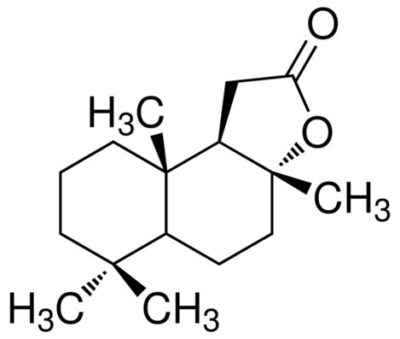A sesquiterpene lactone isolated from plants that is used as a fragance
- Catalog No: APH-95031
- CAS Number: 564-20-5
- Chemical Formula: C16H26O2
- Molecular Weight: 250.38
- Purity: > 99 % CP
- Appearance: White crystalline solid
- Solubility: Soluble in ethyl alcohol and diethyl phthalate; insoluble in water.
- Stability: Stable as a solid over extended period at -20°C.
- Storage: Store at room temperature.
- Shipping: On ice (5°C)
- Handling: Avoid exposure to oxygen and direct sunlight.
Source:
Sclareolide, a sesquiterpene lactone, is derived from various plant sources including Salvia sclarea (Clary sage), Salvia yosgadensis, and cigar tobacco (Kaneko, 1971).
Aphios® has developed an extraction and purification process for the recovery of sclareolide from clary sage bush, Salvia sclarea, using patented SuperFluids™ CXP technology [Castor, US Patent] followed by segmentation chromatography.
Biological Activity:
Its antibacterial and cytotoxic activity have been examined by a group in Tunisia (Hayet et al., 2007). Sclareolide demonstrated good antibacterial activity against common human pathogens, including Staphylococcus aureus, Pseudomonas aeruginosa, Escherichia coli and Enterococcus faecalis (Hayet et al., 2007).
Sclareolide is not generally known for its bioactive properties. Instead, it is mostly used as a fixative or base in the perfume industry, replacing the expensive ambergris believed to originate in the intestines of the sperm whale, an endangered and rapidly vanishing species (Schneider et al., 1996). Its perfumery uses include amber, ambergris, maple, pepper, spice, tea and tobacco. It is also used in cosmetics, because it is thought to contribute to tanning of skin and/or darkening of hair (Moser et al., 2010).
References:
Castor T. (1998). Method and Apparatus for Isolating Therapeutic Compositions from Source Materials. US Patent No. 5,750,709.
Hayet E, Fatma B, Souhir I, Waheb F, Abderaouf K, Mahjoub A, and Maha M. (2007). Antibacterial and cytotoxic activity of the acetone extract of the flowers of Salvia sclarea and some natural products. Pak J Pharm. Sci 20: 146-148.
Kaneko H. (1971). Aroma of cigar tobacco. II. Isolation of norambreinolide from cigar tobacco. Agric Biol Chem 35. (9): 1461–1462.
Moser P, Moussou P, Danoux L and Freis O. (2010). Cosmetic compositions comprising sclareolide and hesperidin methyl chalcone. US Patent Application No. 2010/0183527 A1.
Schneider, M, Stalberg T and Gerke T. (1996). Process for the production of sclareolide. US Patent No. 5,525,728.

